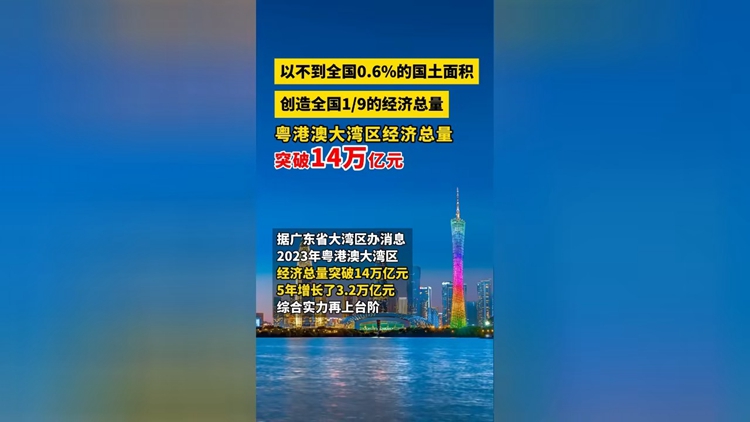GUANGZHOU, April 1 (Xinhua) -- The total economic output of the Guangdong-Hong Kong-Macao Greater Bay Area exceeds 14 trillion yuan in 2023, creating 1/9th of the country's total economic output with less than 0.6 percent of the country's land area, and taking its comprehensive strength to a new level, a reporter was informed by the Guangdong Provincial Office of the Greater Bay Area.
Zhu Wei, executive deputy director of the Guangdong Provincial Office of the Greater Bay Area, said the total economic output of the Greater Bay Area was 10.8 trillion yuan in 2018, an increase of 3.2 trillion yuan in five years. With the in-depth implementation of the Outline of the Plan for the Development of the Guangdong-Hong Kong-Macao Greater Bay Area, especially since 2023, Guangdong has joined hands with Hong Kong and Macao to accelerate the construction of a world-class Bay Area, the best Bay Area in terms of development, and the results of the construction have been obvious, centering on the brand-new "One Point, Two Places" positioning.
The capacity of science and technology innovation has been continuously upgraded. The construction of the Guangdong-Hong Kong-Macao Greater Bay Area International Science and Technology Innovation Center, Comprehensive National Science Center, and High-level Talent Highland has been comprehensively promoted, and the Pengcheng Laboratory, Guangzhou Laboratory, and other "national important instruments" have been laid out one after another. The Greater Bay Area has more than 75,000 national high-tech enterprises, and a number of science and technology leaders such as Huawei, Tencent, BYD, Midea and Gree have emerged. The "Shenzhen-Hong Kong-Guangzhou" technology cluster has ranked second in the world for four consecutive years.

The network of internal and external connections has been accelerated and improved. The "Greater Bay Area on rails" has been improved, with the completion and operation of the Hong Kong-Zhuhai-Macao Bridge, which has basically realized one-hour connectivity between major cities in the Greater Bay Area. The annual passenger throughput capacity of the airports in the Greater Bay Area exceeds 280 million, and the annual container throughput capacity of the ports exceeds 85 million TEUs. The air route network covers major cities in the world and the world's major trading ports.
The construction of major cooperation platforms has been accelerated. Hengqin was officially closed on March 1 this year. Qianhai has introduced the first investor protection regulations in China and actively promoted cooperation with Hong Kong in modern service industries such as finance and law; Nansha has set up three major exchanges for futures, shipping and data, and a comprehensive service base for Chinese enterprises to "go global" has been inaugurated; and cooperation between Shenzhen and Hong Kong in science and technology and innovation in the Loop has started to gain momentum.
The level of market integration has been gradually improved. A number of landmarks have been implemented, such as the "Hong Kong-Macau Pharmaceuticals and Medicines Link", the "Bay Area Social Security Link", the "Cross-border Financial Management Link", and the "Cross-border Office" for government services. A number of landmark projects have been implemented. Since the implementation of the policies of "Macao vehicles going northward" and "Hong Kong vehicles going northward", the number of Hong Kong and Macao single-license plate vehicles entering and leaving Hong Kong and Macao through the Zhuhai Highway Port of the Hong Kong-Zhuhai-Macao Bridge (HZMB) has exceeded 2 million. The number of "Bay Area Standards" jointly announced by the three places, covering such areas as food, Chinese medicine and elderly care, has reached 183.

